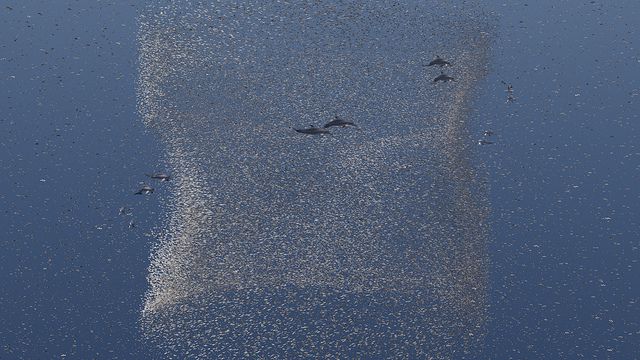
Prey 'Buffets' Help Fuel Healthy Ocean Ecosystems

Marine animal populations thrive when presented with dense and accessible patches of prey, as opposed to just more of it, according to new research.
It turns out that sheer abundance of food is less important than what scientists sometimes call "patchiness" — the spatial distribution of a food source. Marine animals, from birds to dolphins, are able to home in on dense patches of food, making a more efficient use of precious energy for mealtime.
"Patchiness is not only ubiquitous in marine systems, it ultimately dictates the behavior of many animals and their relationships to the environment," Kelly Benoit-Bird, an Oregon State University oceanographer, said in a statement.
Benoit-Bird is the lead author of a study published this week in the journal Biology Letters. The research used sound waves to pinpoint the distribution of krill and other anchors of the food chain in waters near Hawaii.
The scientists found that the tiny crustaceans weren't uniformly distributed, but instead congregated in patches. This explained why two colonies of fur seals and seabirds were faring poorly but a third was healthy, the researchers said.
"The amount of food near the third colony was not abundant," Benoit-Bird said, "but what was there was sufficiently dense, and at the right depth. That made it more accessible for predation than the krill near the other two colonies."
The team also found that a type of bird that feeds on krill, called the thick-billed murre, was able to target the densest swarms of the tiny organisms. Murres dove to an astonishing 650 feet (200 meters) below the ocean's surface in search of their prey.
Sign up for the Live Science daily newsletter now
Get the world’s most fascinating discoveries delivered straight to your inbox.
"The murres are amazingly good at diving right down to the best patches," Benoit-Bird said. It's not clear how the birds identify these feasts lurking deep beneath the surface of the ocean, she added.
The team used sound waves not only to identify the gatherings of krill but to track murres, dolphins, squid and other animals. Time and again, they found that by locating the densest clouds of phytoplankton, tiny ocean plants that are themselves a food source for krill, it was possible to figure out where these larger animals would gather.
Although the concept of "patchiness" is not new, Bird-Benoit said, it may play a larger role in the health of ocean ecosystems than thought.
"Now we need more research to determine how different species are able to determine where the best patches are," she said.












